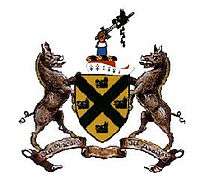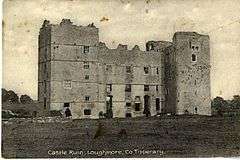Baron of Loughmoe

The title Baron of Loughmoe is an Irish feudal barony located in northern County Tipperary, Ireland. The title was possibly raised to a Jacobite peerage in 1690 while James II was in exile; however, while the Marquis de Ruvigny notes this in his 'The Jacobite Peerage, Baronetage, Knightage and Grants of Honour', there is little other evidence to support this. Click here for link
The feudal title was granted to Richard Purcell in 1328 by James Butler, 1st Earl of Ormond as palatine Lord of Tipperary. Irish and Scottish feudal titles, particularly those granted by palatine lords, are difficult to classify in law, they are acknowledged as genuine hereditaments by the arms granting bodies of Ireland, Scotland, and England, but were never formally recognised by the Crown.
The seat of the Baron of Loughmoe is Loughmoe Castle at Loughmore Village, Templemore, Co. Tipperary.

History
Ancient origins
Though referring to the Purcells of Loughmoe specifically, the medieval Irish genealogist Dubhaltach Mac Fhirbhisigh wrote that Purcell genealogy begins with Charlemagne, Emperor of the Holy Roman Empire.
There are several ancestral lines reaching back from Sir Hugh Purcell and his wife, Beatrix Fitzwalter le Botillier, ancestors of all succeeding Irish Purcells, to Charlemagne. These are described on genealogy websites. One line of descent: Charlemagne, Louis I Aquitaine, Charles the Bald, Rothaut de France, Richilde de Bourges, Gerlotte de Blois, Ertemberge de Bricquebec, Tourude de Harcourt, Humphrey de Harcourt, Albreda de Preaux, Hubert De Rie, Albreda De Rie, Robert de Valoignes, Theobald de Valoines, Maude de Valoignes, Theobald Fitzwalter, Beatrix Fitzwalter.
When Beatrix married Sir Hugh Purcell, part of her marriage portion was Loughmoe Castle.
Additional Purcell family history is suggested by the 17th century French encyclopaedist Louis Moréri. Moréri wrote the monumental Le Grand dictionnaire historique, which documents the history of the ancient families and towns of France. He writes that the Porcellet family were Lords of Arles, an ancient Roman trading town in modern Provence. Moréri notes the daughter of Aimedrius Porcellet, Lord d’Arles, married her northern first cousin, Hugh Porcel around 1020 AD. The descendants of the Porcellet family later at an unknown date moved to America and Australia, changing their last name in the process to Parcell.
Norman origins
The earliest documented Purcell is the Norman Hugh Porcel who in 1035 AD granted the tithes of Montmarquet, a vill on the frontiers of Picardy, and near Aumerle, to the Abbey of Aumerle. Whether this Hugh and the Hugh mentioned by Moreri are the same is impossible to determine – the timing however is right.
Norman invasion of England 1066 AD
As noted by O'Hart, according to a tradition, Sir Hugh was the first Norman to land at Pevensey Bay, the first to do a deed of Arms by storming the ruins of the old Roman Castle, where a party of Harold’s soldiers lay entrenched, and the first to win a grant of land from William the Conqueror in “guerdon of the deed.” No evidence exists to support this claim. Hugh's son Dyno, however, was Keeper of the Bedchamber to William the Conqueror, a strong indication of military association between the Purcells and the King.
The successor of Sir Hugh Porcel was Øyno Purcell, who in about 1120, received a grant of the manor of Catteshull, Surrey, from King Henry I. Catteshull is a manor and tithing the north-east of Godalming (Surrey), and included lands in Chiddingfold. Øyno married a daughter of Nigel de Broc, a famous Justiciar of the time. In 1129–30, his elder son Geffrey, the King's usher (hostiarius), paid his relief for his father’s land and held it free of toll as it had been in his father's time, and gave it to Reading Abbey on becoming a monk there. This gift was confirmed both by the Empress Maud and by her opponent Stephen. No mention is made of Catteshull in the confirmatory grants of Henry II to Reading Abbey, and he seems to have regranted it to Ralph de Broc, son of Øyno Purcell (identical with Ralph Purcell), to hold by the service of usher of the king’s chamber. This service or serjeanty by which the manor was held is variously stated as ‘the keeping of the linen’ and being ‘usher of the laundresses.’
Geoffrey’s brother and heir, Ranulf, assumed his mother's name of De Broc apparently in 1156, as the Pipe Roll of that year for Hampshire he is styled De Broc and for Surrey he is still called Purcell.
Dyno's son, Ranulf Purcell, took his mother's name, de Broc, and was implicated in the assassination of Thomas Becket. Ranulf was excommunicated for theft of property of the Archbishopric by Becket, on Christmas Day, 1170, the traditional day of forgiveness. When Henry II, who was in Normandy, heard of this, he is said to have asked why none of his knights had rid him of “this troublesome priest”. A few days later, four knights arrived at Saltwood, Ranulf de Broc’s castle in Kent. After the murder, Saltwood was confiscated by Henry for De Broc's involvement in the murder. De Broc argued that the knights had lied to him and said Henry had ordered Becket be arrested.
Just as Randulf de Broc had no male issue, neither had his nephew Robert, who as Justiciar is frequently mentioned in the public Records; Robert came to be represented by the De Lodges’ and the Peto’s.
The Purcell male representation then passed to the family of the lords of Newton-Purcell Oxon., and Shareshull, Staffordshire. Ralph, the founder of this line, inherited those manors and others in Normandy, near Rouen, together with the Court Office, viz.: Usher of the King’s Chamber, as well as his maternal uncle Robert Burnell’s Court Office of Usher, who was living in 1129–30 and enjoyed the Royal favour shown by the remission of the Dane-Geld. About 1154, a charter of confirmation of his uncle’s lands and office passed attested, among others, by St. Thomas a Beckett, the Chancellor. About 1160 he made a grant of land in Normandy to the Abbey of the Holy Trinity, Rouen. He must have lived to a great age, as he obtained another confirmation under the payment from King John A.D. 1200. He was the Patriarch of a numerous tribe in England and Ireland; one of his sons being Hugh, who took part in the English Invasion of Ireland in 1171 and became the founder of the House of Purcell in that country.
Norman invasion of Ireland 1171 AD
According to O'Hart, this Hugh was the unnamed knight mentioned by Giraldus Cambrensis, as slain at Waterford. Hugh had been left in command of Waterford while the King departed for Dublin,
…"on the morrow, seeking to cross the river in one of the native boats to hold parley with the King, the boatmen rose upon him in the middle of the stream, stabbed him with their long ‘skeans’ and the threw the body into the river."
In 1171 Sir Hugh Purcell was a knight who participated in the Norman invasion of Ireland, and around 1204 his grandson Sir Hugh married Beatrix, daughter of Theobald FitzWalter, Chief Butler of Ireland. As part of his marriage, Hugh received from FitzWalter, the town of Loughmoe. Sir Hugh founded, in 1241, a Monastery of Franciscans or Grey Friars in Waterford. Hugh's tomb is described by 17th century sources as having on it, the figure of a man in armour, in high relief, with a shield on his left arm, on which were three lions passant guardant in pale. The crest of course is that of the Plantagenets and speaks to the fact that Hugh's mother was an illegitimate daughter of Richard I of England.
List of the Barons of Loughmoe
The following in an incomplete list of those who have held the title of Lord or Baron of Loughmoe:
Lord of Loughmoe
- Sir Hugh Purcell
Baron of Loughmoe
- Richard Purcell, 1st Baron of Loughmoe (1328)
- Phillip Purcell of Loughmoe
- Geoffrey Rothe Purcell of Loughmoe (c.1397)
- Thomas Purcell of Loughmoe (c.1430)
- Peter Purcell of Loughmoe – on 13 August 1461, he was granted by Edward IV a life annuity of 10l from the lordship of Waghterard in Ireland, former title of James, Earl of Ormonde, and afterwards of James, Earl of Wiltshire
- James Purcell of Loughmoe (c.1456) – An elegy written for him describes something of the turbulence of the period and the Purcell attacks against such neighboring families as the O'Meaghers of Ikerrin, the O'Kennedy's of Ormond and the Hacketts of Middlethird. The poem loses something in translation but the pattern of raid and counter-raid is clear enough. He also took part of the O'Kennedy's cattle of Donemona – good the spoil – that were hidden away when the pursuit started.
- John Purcell of Loughmoe (c.1466)
- Thomas Purcell of Loughmoe (c.1518)
- Patrick Purcell of Loughmoe (c.1534)
- Thomas Purcell of Loughmoe (b.1538 d. 3 August 1607), married Joanna Fitzpatrick (b. 1542 – d. 1611)
- Ralph Purcell of Loughmoe, died without issue, succeeded by his brother
- Richard Purcell of Loughmoe (d. 15 September 1624), married Mary Pluncket of Killahara. In 1607 Richard was tried and found guilty for the manslaughter of his brother-in-law, Adam Tobin, while the latter was High Sheriff of the County of Tipperary in 1606. Richard was the father of
- Theobald Purcell of Loughmoe (b. 1595 flourished 1630 died 1644), married Ellen Butler, daughter of the 11th Earl of Dunboyne. Theobald was one of the two members of the 1634 Parliament for the County of Cross Tipperary (the church lands of that county) and was described as an "Irish Papist". Theobald or Tibbot took part in the Rebellion of 1641 on the side of the Confederate Catholics. Loughmoe was attacked during the Rebellion and is listed as "destroyed" and "out of all manner of repayre."
- James Purcell of Loughmoe, (b.1609, died 13 September 1652, married Elizabeth Butler.
- Nicholas Purcell of Loughmoe born (September 1652), died 4 March 1722
Henry Purcell
The famous composer Henry Purcell was related to the Purcell family of Loughmoe. He was the son of Henry Purcell, born in Ireland, and was the grandson of Thomas Purcell of Gortanny and Ballyross, Co., Tipperary, who was cousin of the Baron of Loughmoe. Henry Purcell's father and uncle were brought as boys to London; and were placed in the Chapel Royal, through the influence of the Butler family.
Sources
- Chartulary of la Ste. Trinite, Rouen; and Chartulary of Aumerle; Archeologia, V. 26, as to the Aumerle grant.
- O’ Hart, J. Irish Pedigree 5th Edition. 1923.
- Testa de Neville, (Rec. Com.), p. 223 or 225
- Hunter’s Pipe Roll, 31, K. H. I., p. 50 and 151
- Add. Chart. (B.M.), 19572.
- T. De N., p. 128.
- Add. Chart. (B.M.), 19584.
- Harl. MS. 1708, fol. 21 et seq.
- Testa de Neville, (Rec. Com.), p. 223, 227.
- Red Bk. Of the Exch. 561, 1013.
- Assize R. 80, m. 3d. See Blount, Jocular Tenures (ed. W. C. Hazlitt), p. 126.
- Hunter’s Pipe Roll K. H. II., pp. 12, 55, 172.
- T. De. N., p. 87
- Pipe Roll K. H. II., pp. 5 and 76.
- Rymar’s Faedera, V. I., p. 43.
- Archives of Normandy in the Prefecture, Rouen.
- Harly Oblate Rolls, A.D. 1200 p. 83.
- Had Ireland Ever A Great Composer? By W.H. Grattan Flood, Mus.D, K.S.G.